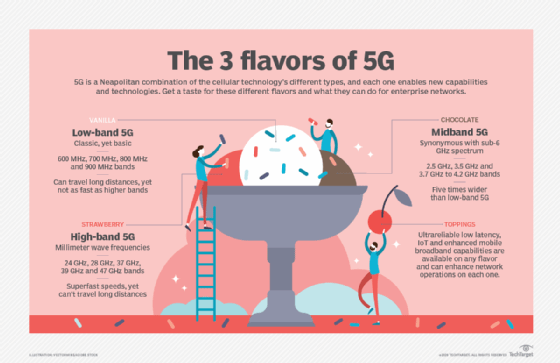Three types of 5G technology explained for enterprise networks
5G spans low-, mid- and high-band spectrum plus NSA and SA deployments, each balancing speed, coverage, cost and complexity as enterprises evaluate use cases from IoT to low-latency networks.
The fifth generation of cellular technology, 5G, isn't a single flavor. In fact, each type of 5G incorporates new, advanced capabilities that can be added to each version.
The different types of 5G comprise the various frequencies on which 5G operates, dubbed low-band, mid-band and high-band 5G. The distinctions among these flavors relate to the different characteristics of each spectrum.
Each 5G type builds on the capabilities of past generations and aims to fix problems those generations created. However, 5G is notable because it enables advanced applications and techniques that make it unique for enterprise networks.
5G is like Neapolitan ice cream, a type of ice cream with three separate flavors in one container. Low-band, mid-band and high-band 5G are like vanilla, chocolate and strawberry, respectively. Three major U.S. carriers -- AT&T, T-Mobile and Verizon -- use all three frequency bands.
Low-band 5G
Low-band is the closest 5G spectrum to 4G and 4G LTE. It operates on the closest frequencies to TV and radio stations. Advantages of low-band 5G include the following:
- Commonly used. Most network professionals are familiar with low-band 5G, and it's fairly basic in terms of advanced frequencies.
- Penetration. Low-band 5G offers significantly better building penetration than other 5G types.
- Far-reaching. Low-band 5G can travel long distances. Some TV stations still use similar frequency bands because they can cover large areas.
- Frequency ranges. Low-band 5G ranges from 600 MHz to 900 MHz, according to the Federal Communications Commission (FCC).
However, low-band 5G isn't without its challenges. The disadvantages of low-band 5G include the following:
- Slower than other 5G types. Low-band 5G isn't as fast as the other flavors, which is why it can travel further. It has a lower capacity to carry data than higher frequencies.
- Low bandwidth. Low-band 5G has low bandwidth.
Mid-band 5G
Mid-band is a bit more advanced than low-band, but it isn't the most hyped type of 5G. Its benefits include the following:
- Synonymous with the sub-6 GHz spectrum. Mid-band 5G ranges from 2.5 GHz, 3.5 GHz and 3.7 GHz to 4.2 GHz bands.
- Wider than low-band. The mid-band 5G spectrum is five times as wide as the low-band spectrum.
- Higher data capacity. Because mid-band 5G is wider than low-band 5G, it has more capacity to transport larger amounts of data.
Cons to mid-band 5G include the following:
- Obstacle interference. Buildings and other solid objects can affect higher ranges of mid-band 5G. However, permeation issues are more prevalent with high-band 5G.
- High deployment costs. Clearing and deploying spectrum and building more towers is costly for carriers.
High-band 5G and millimeter wave
High-band 5G is effectively the opposite of low-band 5G: It can't travel far, but it has superfast speeds that result from 5G's most touted benefits. The FCC states that high-band 5G encompasses the 24 GHz, 28 GHz, 37 GHz, 39 GHz and 47 GHz bands. Benefits include the following:
- Uses millimeter wave. High-band 5G uses mmWave, the spectrum between 30 GHz and 300 GHz, which provides high-speed connectivity and faster download speeds.
- Increased interest. High-band 5G's advanced capabilities -- and mmWave's high bandwidth and ability to carry more data between destinations -- have increased global interest in 5G.
- Advanced use cases. MmWave makes high-band 5G the only type of 5G with potentially distinct use cases compared to the other types. MmWave can support the level of performance and speed that data centers require, more than low-band or mid-band 5G.
Cons to high-band 5G include the following:
- Poor line-of-sight travel. MmWave can't penetrate obstacles, which limits the frequency's range.
- Obstacle interference. Weather situations such as heavy rainfall, for example, could impede mmWave.
- Installation costs. High-band 5G requires dense networks of small cells and proper installation for an organization's successful 5G deployment.
Network deployment types
5G has two deployment options: non-standalone (NSA) and standalone (SA) 5G. Both deployment modes are available across all frequency bands.
NSA 5G
NSA 5G builds upon the existing 4G infrastructure. Rather than operating with a 5G core, NSA 5G combines the 4G LTE core with a 5G radio access network. The 5G radio access network (RAN) enables NSA 5G networks to operate at higher speeds than previous mobile-based networks. It's also faster to deploy NSA 5G because it improves upon existing 4G networks.
However, NSA 5G is still limited by its dependence on 4G. NSA 5G is vulnerable to the same security risks that plague 4G infrastructure. Additionally, although NSA 5G has a simpler deployment path, the combination of 4G LTE with 5G RAN consumes more energy, resulting in complexity in managing the infrastructure. Upfront costs might be lower, but the higher power consumption and limited upgrade path to SA 5G make NSA the more costly option in the long term.
Standalone 5G
Unlike NSA 5G, SA 5G uses a 5G-native core, which means it doesn't rely on 4G LTE infrastructure to operate. This leads to improved performance, stronger security and more flexibility. SA 5G also enables new applications that NSA 5G can't support due to its older architecture. Use cases that SA 5G can enable include IoT, smart cities, autonomous vehicles and more.
However, because SA 5G is a new architecture, it requires new hardware and equipment to build the network from scratch. SA 5G is still evolving, which can make deployment more challenging. Network operators might not be as familiar with the hardware, protocols and standards as they are with 4G infrastructure, and this inexperience can make deployment more challenging. Complex deployment can create issues with the infrastructure, and the lack of mature SA 5G protocols could make the network more susceptible to security risks.
Although SA 5G initially costs more to deploy than NSA 5G, its new infrastructure means it doesn't need to be upgraded in the future. This makes SA 5G the less expensive option between the two 5G deployment options in the long run.

Other assorted 5G capabilities
Dynamic spectrum sharing is one capability all types of 5G can use. Other capabilities include ultra-reliable low-latency, IoT capabilities and enhanced mobile broadband.
Dynamic spectrum sharing
Dynamic spectrum sharing permits different 5G frequencies to exist on the same spectrum as 4G. This sharing has become more prevalent as carriers shut down spectrums they allocated to 2G or 3G technologies and invest in spectrums that 4G and 5G could operate on together.
Dynamic spectrum sharing can benefit organizations that already employ 4G technology and are unsure whether a 5G investment would be worthwhile. 4G can still serve many use cases. Organizations that want to add 4G to their 5G connectivity can use dynamic spectrum sharing to enable that combination.
Ultra-reliable low-latency
5G is built to support ultra-reliable low-latency communications (URLLC), enabling quick responses to requests and benefiting areas such as automation and video conferencing.
Further, URLLC can save organizations money, as it enables remote communication. Communication could be instantaneous with 5G, even without a person's physical presence. This connectivity can also enhance facial recognition and video surveillance capabilities.
IoT capabilities
The three types of 5G can enable massive machine-type communication, which is the ability for machines to communicate with one another without human intervention, like IoT. In particular, 5G enables narrowband IoT, a low-power IoT technology that can benefit and support a large number of IoT devices.
Narrowband IoT also enhances mobile device battery life, so an IoT sensor battery could last up to 10 years. Additionally, if an organization has disparate systems for all its connected devices, 5G could consolidate them into a single network. Each type of 5G aims to quickly and reliably support all connected devices on a single 5G network with these new capabilities.
Enhanced mobile broadband
Enhanced mobile broadband capability improves standard mobile broadband operations. It can also cut an organization's costs on wired connectivity.
This enhanced broadband is the reason experts have questioned whether 5G will replace Wi-Fi, as it offers faster, more flexible and more reliable connectivity than traditional cellular technology and Wi-Fi.
Editor's note: This article was updated to reflect changes in the carriers' use of 5G bands.







